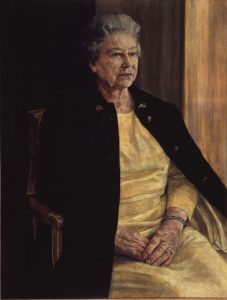
Detail of Lord Elphinstone by Philip de Laszlo Member of the Royal Society of Portrait Painters
During the last quarter of the 19th century, interest in portrait painting revived. It not only became fashionable to commission portraits as a means of celebrating and honouring those of high rank or achievement, but it was becoming a genre worthy of critical attention.
The Royal Academy, however, remained closed to portraits by those beyond its doors and consequently, a number of young painters banded together, ‘the front rank of Outsiders’ as the Magazine of Art called them, to form their own movement.
1891 A committee comprising Archibald John Stuart-Wortley (chairman), James Jebusa Shannon, George Percy Jacomb-Hood, Arthur Melville, and Hon. John Collier carried a proposal to form a Society of Portrait Painters. Wortley was its first President and its first exhibition was deemed a critical success.
The catalogue of the exhibition shows that its committee then consisted of Archibald Stuart-Wortley (Chairman), Hon. John Collier, Arthur Hacker, G. P. Jacomb-Hood, S.J. Solomon, James Jebusa Shannon, and Hubert Vos. The other members listed were Percy Bigland, C. A. Furse, Glazebrook, John McLure Hamilton, Heywood Hardy, Hubert von Herkomer, Henry J. Hudson, Louise Jopling, T. B. Kennington, W. Llewellyn, W. M. Loudan, Arthur Melville, Anna Lea Merritt, F. M. Skipworth, Mrs. Annie Swynnerton, W. R. Symonds, Mary Waller, Edwin A. Ward, Leslie Ward (better known as “Spy”), and T. Blake Wirgman.
1892 The second exhibition was considered to surpass the first with works by John Everett Millais, Frederick Leighton, and members of the Glasgow School, John Lavery, and James Guthrie.
G F Watts, Alma Tadema, and James McNeill Whistler were made members.
1893 John Singer Sargent was established at the forefront of their rank. An annual exhibition launched in the newly opened Grafton Galleries in New Bond St.
1902 The Athenaeum magazine wrote ‘the mere fact that Mr. Watts contributes some of the work of his prime, raises the exhibition above the ordinary level of contemporary shows’
1911 In its 21st year the society gained Royal patronage from King George V, becoming the Royal Society of Portrait Painters (RP). A new wave of painters joined including William Orpen, who broke with past conventions and sought new forms of expression.
1917 The Society put on an exhibition at the Walker Gallery in Liverpool to raise funds for the war effort.
1920 The Grafton Gallery lease expired and the RP moved between the Royal Academy and the R.B.A Galleries for some years before finding a permanent home at The Royal Institute Galleries in Piccadilly, until these were bombed in 1940.
1923 The President and founding member, J.J. Shannon died and was replaced by William Orpen, a President remembered for his magnanimity in instantly writing a cheque to settle the Society’s debts. Orpen was replaced on his death by Lavery, in 1931. During the years that followed such luminaries as Laura Knight, Augustus John, Alfred Munnings among others became members and exhibited with the Society, innovating and propelling it in new directions.

H M The Queen by Antony Williams RP. Winner of the Ondaatje Prize for Portraiture, Royal Society of Portrait Painters 1995
1941 The Society announced a permanent Gallery at 6 ½, Suffolk St, Pall Mall East, London SW1, where the painters’ work could be seen at any time of year
1961 The RP became a founder member of the Federation of British Artists (FBA)
1971 The FBA moves to the Mall Galleries in London
1984 It was announced by the society ‘The President and members have the honour to announce that Her Majesty the Queen has been graciously pleased to grant Her Patronage to the Royal Society of Portrait Painters.’
1986-7 The RP was incorporated as a private limited company and also became a Registered Charity, overseen by John Walton RP.


